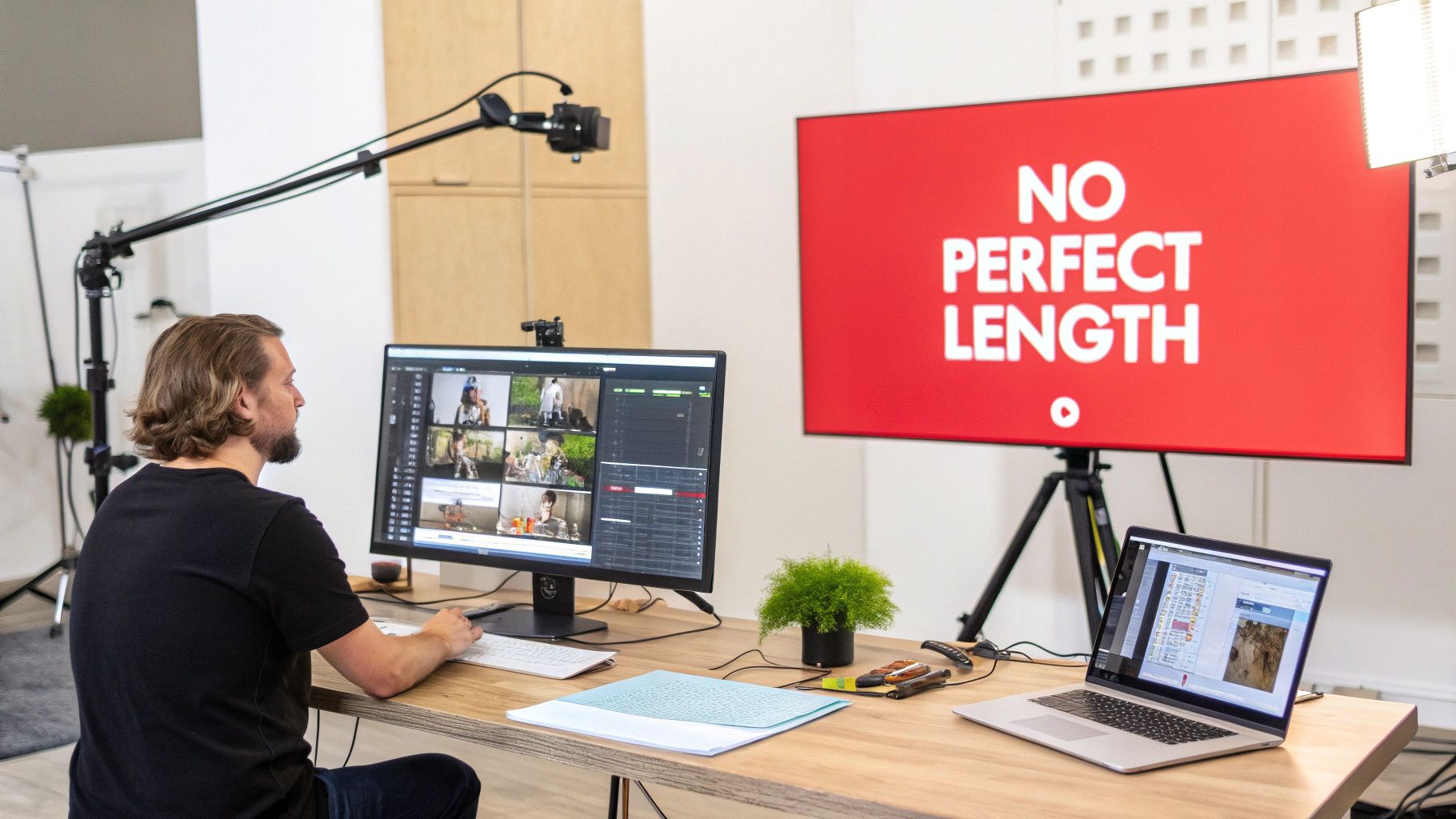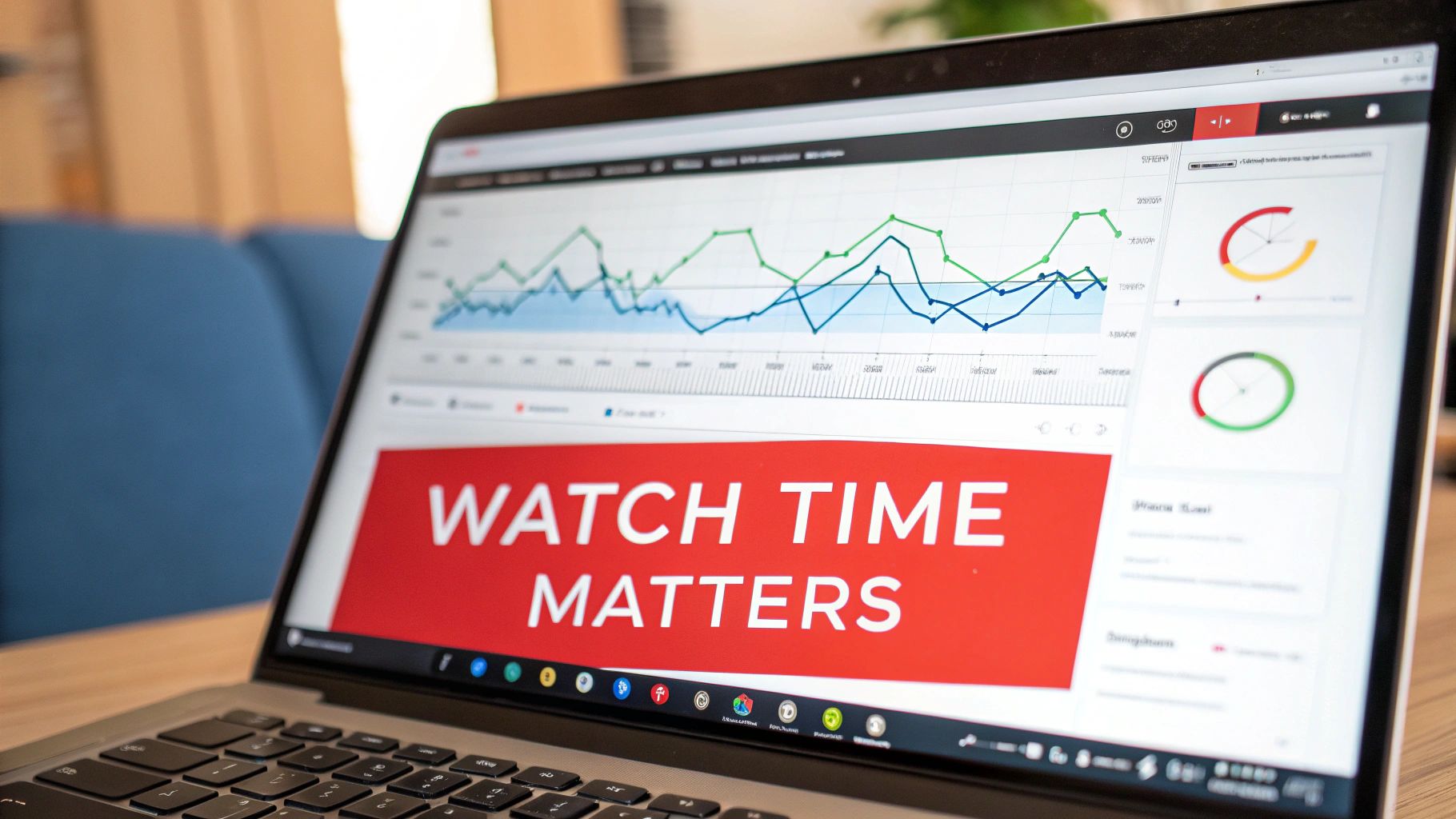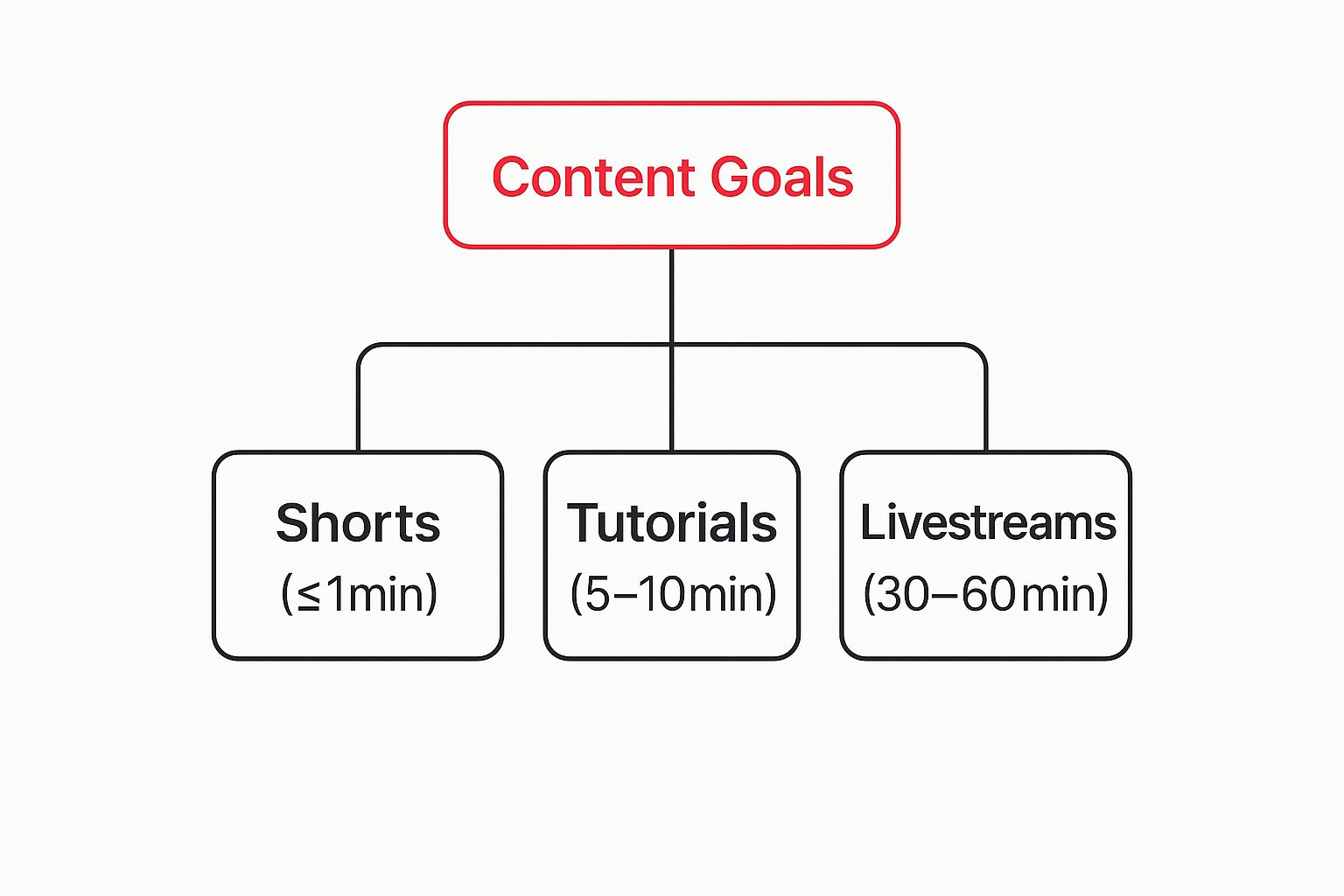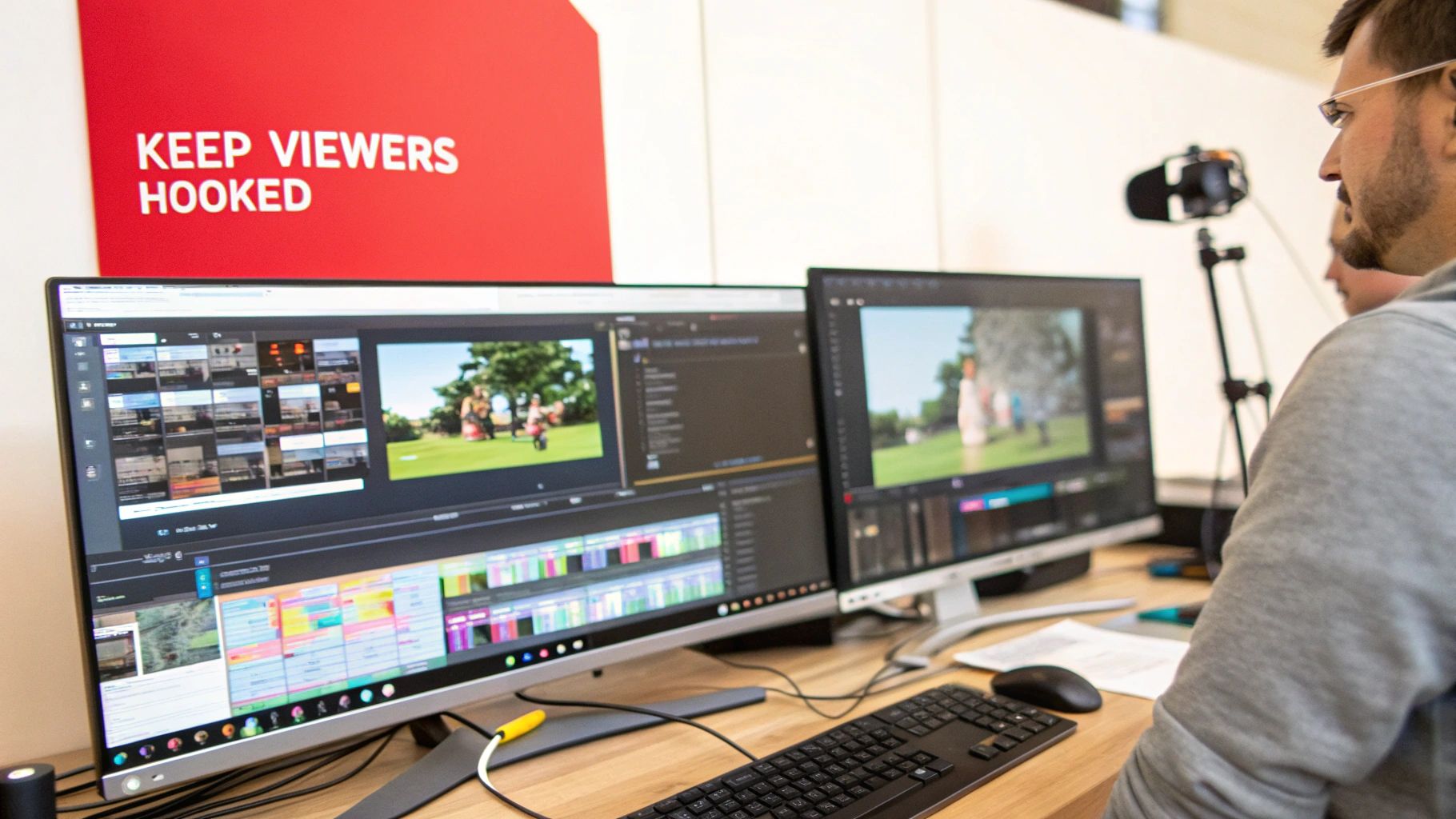Let’s cut right to the chase: there's no magic number for the perfect YouTube video length. Anyone who tells you otherwise is selling something.
The right length for your video depends entirely on your topic, your audience, and what you’re trying to achieve. A quick-and-dirty tutorial might clock in at three minutes, while an in-depth documentary could easily run an hour—and both can be wildly successful.
Finding the Sweet Spot for Video Duration

So many creators get hung up on hitting a specific time, but the truth is far more nuanced. Think of it like a conversation. A quick "hello" is short and sweet, but a deep, meaningful chat needs more time to unfold. Your video should be exactly as long as it needs to be to deliver its promise to the viewer—and not a single second longer.
The real goal here is to stop thinking about a one-size-fits-all number and start making smart, strategic decisions. The question isn't, "How long should my YouTube video be?" It's, "How much time does this specific story or idea need to be told well?" That mental shift is everything when it comes to keeping your audience hooked and making the YouTube algorithm happy.
A Quick Guide to Common Formats
To give you a practical starting point, we've pulled together some data-backed suggestions for popular video formats. Think of these as proven baselines, not unbreakable rules. They're based on what we see working right now in terms of viewer engagement.
For example:
- Tutorials & How-To Guides: People are here for an answer, fast. Get straight to the point.
- Product Reviews: Viewers need enough detail to trust your opinion and make a smart purchase.
- Vlogs: The length is all about the story you're telling. Does it have a clear beginning, middle, and end?
- Educational Content: You need to go deep enough to be valuable but break things down so they're easy to follow.
The core principle is simple: Your video should be as long as it needs to be to provide value, and no longer. Padding a video to hit an arbitrary time will always hurt your audience retention more than it helps.
To make this even clearer, here’s a quick reference table breaking down these formats. It's a great starting point, and we'll dig into the "why" behind these numbers throughout the rest of this guide.
Recommended YouTube Video Length by Content Type
This table is a quick reference guide to suggested video durations for popular YouTube content formats based on audience engagement data.
| Content Type | Recommended Length Range | Primary Goal |
|---|---|---|
| Tutorials & How-To Guides | 3–10 minutes | Provide a clear, fast solution to a specific problem. |
| Vlogs | 10–18 minutes | Share a personal story or experience to build community. |
| Product Reviews | 8–15 minutes | Offer in-depth analysis and build trust with the audience. |
| Educational Videos | 12–25 minutes | Explain a complex topic thoroughly and establish authority. |
| Comedy/Sketch | 2–5 minutes | Deliver a quick punchline or entertaining concept. |
| Gaming Highlights | 5–12 minutes | Showcase the most exciting moments of gameplay. |
These ranges give you a solid framework to work from as you plan your content. They balance delivering real value with holding onto viewer attention—the ultimate tightrope walk for any creator.
How the YouTube Algorithm Sees Video Length

To really get a handle on the ideal YouTube video length, you first have to get inside the "mind" of the algorithm. It's not some magical being with artistic taste. It’s a powerful system with a single, clear goal: keep people on YouTube for as long as possible.
Think of the algorithm as a pragmatic film festival judge. It doesn't just hand the grand prize to the longest movie. Instead, it pays close attention to how the audience is reacting. A three-hour epic that has everyone on the edge of their seats? That's a winner. But a 90-minute film that has people walking out after 20 minutes? That's a dud.
Your videos are being judged the exact same way. The algorithm isn't just looking at the total runtime; it's measuring how well that runtime keeps a viewer's attention.
The Two Metrics That Matter Most
The algorithm looks at a lot of different signals, but when it comes to video length, two metrics are king: Watch Time and Audience Retention. Nailing the difference between them is the key to creating videos that YouTube actually wants to promote.
- Total Watch Time: This one’s straightforward. It's the grand total of all the minutes people have spent watching your video. If 1,000 people watch your 10-minute video for an average of 5 minutes, you've generated 5,000 minutes of Watch Time.
- Audience Retention: This is the percentage of your video that viewers watch on average. In that same example, your Audience Retention is 50%, because viewers watched 5 minutes of a 10-minute video.
Now, it's true that a longer video has the potential to rack up more Watch Time, which the algorithm loves. But that potential only becomes reality if your Audience Retention is solid.
A super-engaging five-minute video that people watch all the way through will always beat a rambling 15-minute video that people click away from after two minutes. The quality of that engagement crushes sheer length every single time.
The scale of this is just massive. Every single day, people watch over 1 billion hours of video on YouTube. With around 2.5 billion monthly users, the algorithm has an unbelievable amount of data to learn what keeps people watching.
Why Engagement Is Everything to the Algorithm
At the end of the day, YouTube is a business, and its business runs on ads. The more time people spend watching videos, the more ads they see. It's that simple.
So, the algorithm is built to find and push the videos that are proven to keep viewers on the platform longer.
When your video shows high Watch Time and strong Audience Retention, you're sending a direct signal to YouTube that says, "Hey, this content is doing its job! It's keeping people here!" The algorithm sees that signal and rewards you by showing your video to more people, which kicks off a powerful cycle of growth.
This is why you have to treat your YouTube video length as a strategic choice, not just a random number. You're looking for the sweet spot—the perfect amount of time to tell your story in a compelling way that maximizes how long a viewer is willing to stick around. For a deeper look at these mechanics, check out this guide on how the YouTube algorithm really works.
Ultimately, a long video with terrible retention is a big red flag for the algorithm. It suggests your video didn't live up to its promise. On the flip side, a shorter video with fantastic retention is a huge green light, proving you know how to capture and hold an audience. Your job is to find that perfect balance for your topic and your viewers.
Matching Video Length to Your Content Goal
Before you even think about hitting record, you need to ask yourself one simple question: "What's the point of this video?" The answer to that question is your single best guide for figuring out how long it should be. The optimal YouTube video length isn't some magic number you pull out of a hat; it’s a strategic choice tied directly to your goal.
Think of it like planning a road trip. If you just want a quick, fun drive to the beach (your goal), you don't map out a cross-country route. But if you're trying to explore every national park along the way, a 30-minute drive won't cut it. The length of the journey has to match the destination.
Quick Entertainment vs. Deep Education
The most common split comes down to two very different objectives: giving someone a quick laugh or teaching them something valuable. Each one calls for a completely different runtime.
-
For Quick Entertainment (Shorts & Memes): The name of the game is instant gratification. People are scrolling for a quick hit of dopamine, not a lecture. Your video has to be short, punchy, and deliver its payload immediately—we're talking under 60 seconds.
-
For In-Depth Education (Tutorials & Explainers): Here, your viewer is on a mission. They have a problem and believe you have the solution. They're ready to invest some time to learn, so videos in the 5 to 15-minute range work beautifully. This gives you enough runway to explain things clearly without padding for time.
This infographic breaks down how your content's goal should dictate its length.

As you can see, as the goal moves from a quick laugh to building a real connection, the expected length naturally grows with it.
Building Community and Driving Action
What if your goal isn't just to entertain or teach? Sometimes you want to build a loyal following or convince someone to take the next step, like buying a product. These goals have their own sweet spots for video length.
Livestreams, for example, are all about community. Their power comes from real-time interaction, which you just can't fake in a short clip. A good livestream often runs for 30 to 60 minutes (or more!), creating an event where your audience can hang out with you and each other. The length itself is what makes it feel special.
A video's duration should be a direct reflection of the promise made in its title and thumbnail. A title promising a 'Quick Tip' should lead to a short video, while one offering a 'Complete Masterclass' sets the expectation for a much longer format.
When you want to drive action, like with a product review, you need to build trust. A detailed review might take 8 to 20 minutes to walk through all the features, what you like, and what you don't. Rushing it feels like a sales pitch; dragging it on feels like you're wasting their time. Your job is to give them enough solid info to make a decision they feel good about.
The Role of Watch Time in Monetization
Let's be real—for many creators, monetization is a big goal. And that brings us right back to watch time. To get into the YouTube Partner Program, you have to hit a certain number of watch hours. It’s tempting to think that longer videos are an easy shortcut.
But here’s the trap: artificially bloating your videos with fluff is the fastest way to kill your channel. Viewers will click away, your audience retention will plummet, and YouTube's algorithm will stop showing your video to new people.
The only sustainable strategy is to create content that is so good it earns its runtime. When you do that, you're not just keeping viewers engaged; you're also making steady progress toward your watch-hour goals. For anyone serious about making a living on the platform, learning the fastest way to get 4000 watch hours on YouTube means mastering that delicate balance between length and value.
How Your Video Format Changes the Length Game
Think of it this way: you wouldn't write a tweet with the same structure as a novel. The format dictates the approach. The same exact principle applies to your YouTube videos. The format you choose is a massive signal to your audience, setting their expectations for how long they should stick around.
A person hunting for a quick fix for a leaky faucet is in a totally different headspace than someone settling in for a long-form documentary. One wants a fast, straight-to-the-point answer. The other is ready to invest their time for a deep, satisfying story. Nailing this difference in viewer intent is everything.
Vlogs and Personal Storytelling
Vlogs are all about connection. People click on them to hang out with you—to see a slice of your life or hear what’s on your mind. Because it’s so relationship-driven, you’ve got a bit more wiggle room on length. That said, the sweet spot is usually between 10 and 18 minutes.
That's just enough time to tell a good story with a real beginning, middle, and end, without making it feel like a chore to get through. The trick is to match the length to the story. Simple story? Shorter video. More complex day or a big event? Go a little longer.
Educational Guides and How-To Content
When you're teaching something, your audience just wants the answer. They have a problem, and they came to you for the solution. Get straight to it. For how-to videos, the ideal length typically falls between 5 and 15 minutes.
Your mission is to be as long as you need to be to solve the problem completely, but not a second longer. Ditch the long, rambling intros and cut out the fluff. A great way to structure these is by breaking the process into super clear, numbered steps. This not only helps your viewer learn but also keeps the video moving at a good clip, showing you respect their time.
Viewer trust is built on delivering exactly what your title promises. If your video is called "Quick 3-Minute Tip," it better not be a 10-minute ramble. Honoring that unspoken contract is crucial for audience retention and building a loyal subscriber base.
Since YouTube first launched, the average video length has crept up, now sitting somewhere around 11.7 to 12.5 minutes globally. But that's just an average! Music videos are a quick 6.8 minutes, while educational content often blows past the average because people will absolutely invest their time for good information. You can dig into more of these fascinating YouTube user statistics on Global Media Insight.
Product Reviews and In-Depth Analysis
With product reviews, your most valuable asset is trust. Viewers are often on the fence about a purchase, and they're looking to you for an honest, detailed breakdown. A review that feels rushed seems sketchy, but one that drags on and on gets boring. You'll want to aim for the 8 to 20 minute range.
This gives you plenty of time to walk through everything they need to know:
- Unboxing and First Impressions: Let them see the product like they just got it themselves.
- Key Features and Specs: Explain what it does and why it matters.
- Real-World Testing: Show the product in action—the good, the bad, and the ugly.
- Final Verdict and Recommendation: Bring it all together and give them a clear takeaway.
When you structure a review this way, the longer runtime feels justified because you're packing every minute with value.
Shorts and Quick Entertainment
The explosion of short-form video created a whole new ballgame with its own set of rules. YouTube Shorts have a hard cap: 60 seconds or less. The name of the game is instant impact.
You have to hook someone in the first two seconds and deliver the goods—a punchline, a cool visual, a wild fact—right away. There's no time for a slow burn. If you're serious about this format, there are even specialized tools for optimizing short-form video content that can provide deeper insights into what really works. Just remember, Shorts aren't mini-versions of your regular videos; they're a completely different art form built for speed and discovery.
Optimal Video Length and Retention Strategy by Format
To pull this all together, here’s a quick-glance table comparing how different video formats stack up in terms of length and the best way to keep your audience watching.
| Video Format | Typical Length | Viewer Expectation | Key Retention Tactic |
|---|---|---|---|
| Vlogs | 10–18 min | Personal connection, entertainment | Build a strong narrative arc with a clear beginning, middle, and end. |
| How-To/Educational | 5–15 min | Fast, direct solution to a problem | Get straight to the point; use timestamps and clear, actionable steps. |
| Product Reviews | 8–20 min | Thorough, trustworthy analysis | Cover all key aspects (unboxing, features, testing, verdict) to justify the time. |
| YouTube Shorts | Under 60 sec | Instant gratification, quick laugh/tip | Hook them in the first 2 seconds and deliver the payoff immediately. |
Ultimately, each format has its own rhythm and its own "contract" with the viewer. By understanding and respecting these unwritten rules, you can create content that feels just right for your audience, no matter what you're making.
Strategies to Boost Audience Retention

Here's a truth every creator needs to hear: a killer five-minute video will crush a boring fifteen-minute one every single time. The secret to getting the YouTube algorithm on your side isn't about hitting some magic number on the clock. It’s all about audience retention—keeping people glued to their screens from the intro to the outro.
Think of your video like a rollercoaster. If the ride starts with a long, slow climb and has too many flat, boring sections, people will want to jump off. But if you pack it with unexpected twists, drops, and thrilling moments, they'll hang on for the entire ride, buzzing with excitement. Your job is to build that experience, regardless of the final YouTube video length.
These strategies are your toolkit for doing just that, turning casual clickers into devoted fans.
The First 15 Seconds Are Everything
You have an incredibly small window to convince a viewer that your video is worth their time. Those first 15 seconds are not the place for a fancy animated logo or a plea for subscribers. This is prime real estate reserved for one thing: the hook.
A powerful hook needs to do one of three things, and it needs to do it fast:
- Ask a burning question the viewer desperately wants answered. (e.g., "What if you could edit your videos in half the time?")
- Drop a shocking statement that makes them raise an eyebrow. (e.g., "This one mistake is costing most YouTubers thousands of views.")
- Show them the amazing end result they're about to learn how to achieve. (e.g., A quick, stunning shot of a finished piece of furniture you built.)
Nail the hook, and you've earned their attention for the next few minutes. Fumble it, and they're gone before you even get to the good stuff.
Use Pattern Interrupts to Maintain Focus
The human brain is hardwired to notice change. When the screen stays static for too long, our minds start to wander. A pattern interrupt is any small change that breaks up the visual or auditory flow, snapping the viewer's brain back to attention.
This doesn't mean you need to be a Hollywood editor. Tiny, simple changes can make a world of difference in your video's pacing, keeping viewers locked in.
Your editing pace is just as important as your speaking pace. A video that feels dynamic and visually interesting gives the viewer's brain a constant stream of new information to process, which prevents boredom from setting in.
Try sprinkling these simple interrupts into your edit every 10-20 seconds:
- Quick Zooms: A subtle punch-in to emphasize a crucial point.
- B-Roll Footage: If you're talking about coffee, show a beautiful clip of coffee being poured. Show, don't just tell.
- On-Screen Text: Use text pop-ups to highlight key terms or stats.
- Graphics & Images: Drop in relevant images or charts to illustrate what you're saying.
Learning how to create engaging content is a skill built on thousands of these small but mighty editing decisions.
Structure Your Narrative for Maximum Impact
Every good video tells a story—even a "how-to" guide. A clear narrative structure acts as a roadmap for your viewer, making the information easier to follow and much more satisfying to watch.
Break your video down into three simple acts: the hook, the core value, and the payoff.
- The Hook: Grab their attention and make a clear promise ("By the end of this video, you will know how to...").
- The Core Value: Deliver on that promise with clear, valuable information. Guide them along with verbal cues, or "signposts," like "Next up, we need to..."
- The Payoff & CTA: Wrap it up with a strong conclusion that summarizes the main takeaway and tells them exactly what to do next, whether it's subscribing or watching another video.
This structure creates a predictable yet rewarding journey, making viewers feel like their time was well spent. For creators looking to boost their video performance, tools like Ytubebooster Pro can provide valuable insights. Mastering these techniques ensures your video’s length becomes an asset, not a liability.
Still Have Questions About YouTube Video Length?
As you start putting all this into practice, a few common questions always seem to pop up. Let's tackle them head-on so you can move forward with a clear, confident strategy. Think of this as the final piece of the puzzle, making sure your approach to video length is solid and built to last.
We'll clear up the confusion around monetization rules, look at how Shorts and long-form videos can work together, and figure out when it makes sense to break up a huge topic into a series.
Does My Video Really Need to Be Over 8 Minutes to Make Money?
This is easily one of the most persistent myths on YouTube, and the answer is a simple, resounding "no." While it's true that videos longer than eight minutes are eligible for mid-roll ads—which can boost your revenue—chasing that number at all costs is a rookie mistake.
Forcing a video to be longer just for the sake of it will hurt you more than it helps.
Remember, the YouTube algorithm wants one thing: to keep viewers happy and watching. If you pad out a fantastic 5-minute idea with 3 minutes of filler just to hit that magic number, your audience retention will tank. Viewers will click away, which tells YouTube your video isn't satisfying, and your reach will suffer.
The Bottom Line: A super-engaging 6-minute video that people watch all the way through will almost always earn more in the long run than a boring 8-minute video nobody finishes. Why? Because the algorithm will push the engaging video to more people, leading to more views, more subscribers, and, ultimately, more ad revenue.
Focus on creating the best video possible for your topic, period. If it naturally and valuably goes past eight minutes, great! You can then strategically place a mid-roll ad or two during natural pauses. But never, ever sacrifice the viewer's experience just to get an extra ad spot.
How Do YouTube Shorts Fit In With My Longer Videos?
YouTube Shorts and long-form videos aren't enemies fighting for attention; they're a powerful team. When you use them together, they create a fantastic growth engine for your channel, with each format playing a distinct but complementary role.
Think of Shorts as the movie trailers for your channel. They are absolute gold for discoverability, helping you reach completely new audiences who might have never stumbled upon your longer content.
Here’s how they work in harmony:
- Shorts for Discovery: Use them to grab attention with quick, high-impact clips. They're perfect for showcasing the most exciting moments from a longer video or sharing a single, powerful tip.
- Long-Form for Community: This is where you build real relationships. Your longer videos are where you deliver deep value, establish yourself as an expert, and rack up the serious watch time that YouTube loves.
A smart strategy uses Shorts to cast a wide net and pull people in. Then, your compelling long-form content is what turns those casual viewers into a loyal, dedicated community. You can tease an upcoming long video with a Short or breathe new life into an older video by turning one of its best moments into a Short.
Should I Split a Really Long Video Into a Series?
Breaking up a massive topic into a multi-part series can be a brilliant move—but only if the content naturally allows for it. This approach works wonders when a big subject has clear, self-contained sections that can stand on their own as individual videos.
For example, a 60-minute deep dive on "The History of Ancient Rome" is a perfect candidate for a series. You could easily create three 20-minute episodes:
- Part 1: The Rise of the Republic
- Part 2: The Age of Emperors
- Part 3: The Fall of the Empire
This structure makes the content feel way less intimidating to a potential viewer. It also builds anticipation for the next episode and gives you more videos, which means more total views and watch time for your channel.
But this isn't a one-size-fits-all solution. If your video is a continuous, step-by-step process where each part depends on the last one—like a software tutorial or a complex cooking recipe—splitting it up will just frustrate your audience.
In those cases, a much better idea is to keep it as a single video and use YouTube's chapters feature. Chapters let viewers jump directly to the sections they care about, giving them a great experience without breaking the flow of your teaching.
Ready to fast-track your YouTube journey? MonetizedProfiles offers fully approved, monetization-ready YouTube accounts, so you can skip the grind and start earning from your content on day one. Find your perfect monetized YouTube account at MonetizedProfiles and focus on what you do best: creating amazing videos.







